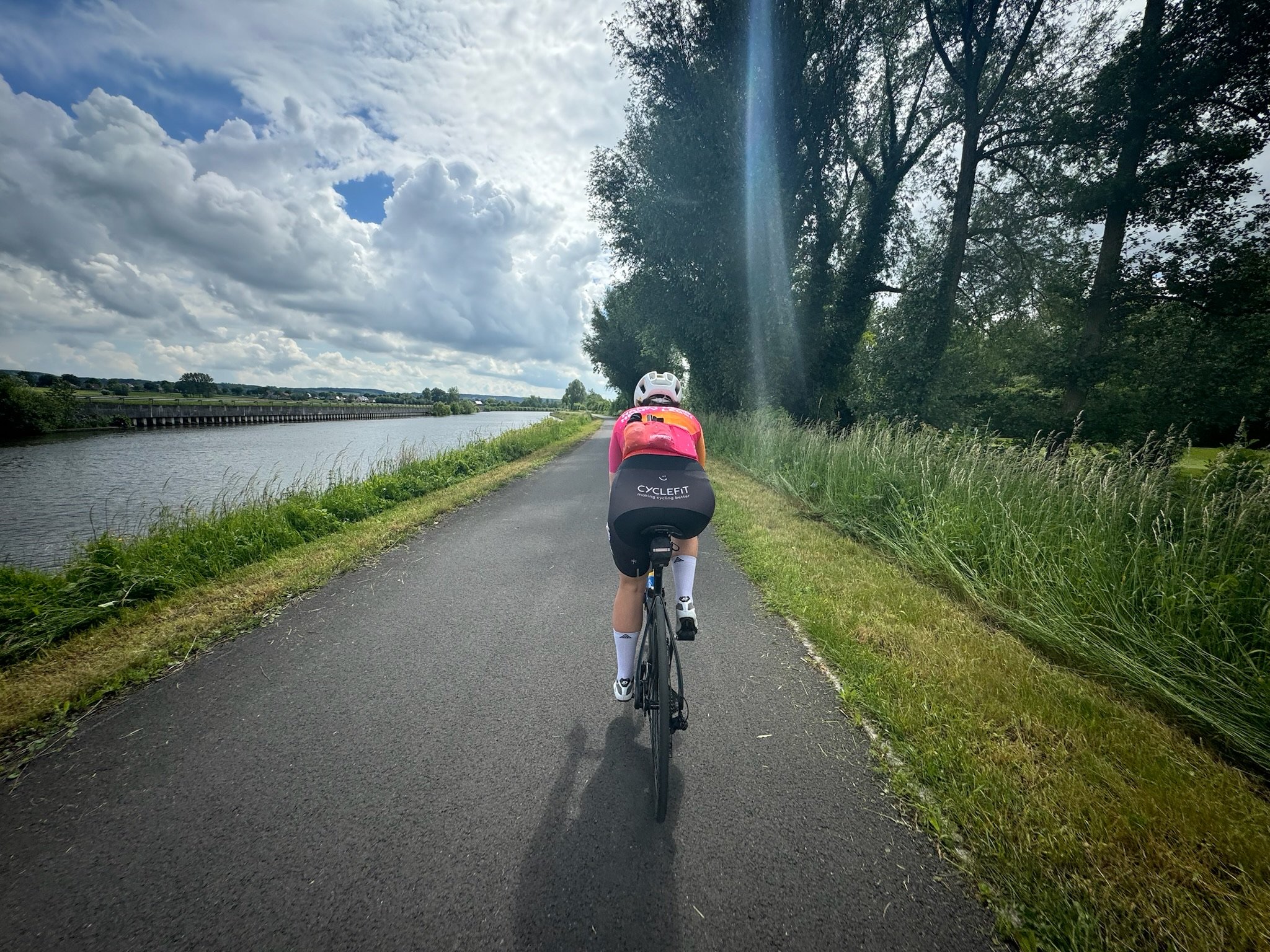We can’t set your personal best for you, but this might help.
-

CdA and Aerodynamic Testing.
Optimise your time trial and best efforts with our CdA Calculator. Designed to help you fine-tune your aerodynamic position, this virtual wind tunnel tool allows you to test and refine your setup on your training loop. By measuring your coefficient of drag area (CdA), you can identify the most efficient riding posture, reducing drag and maximising your speed. Perfect for those seeking to shave off valuable seconds and achieve their personal bests.
-

Race Prediction.
Optimise your race strategy with our aerodynamic Race Predictor. Input your target time or desired wattage, and we'll calculate the ideal power output and CdA combination. Gain invaluable insights to refine your position, minimise drag, and maximise your speed for a competitive edge on race day. Unlock your true potential and achieve a smoother and faster ride. Reach your goals and enjoy your best performance yet.
-

Power to Speed Relationship.
The Power to Speed Relationship tool helps you understand the relationship between cycling speed and power output. By entering your power, weight, bike weight, CdA values, air density, and rolling resistance, it calculates your expected speed. It shows how different setups affect performance and highlights diminishing returns from increased power. Showinghowaerodynamics can impact performance more than power!

CdA and Aerodynamic Test Tool
Accurately assessing aerodynamic performance allows riders to evaluate efficiency, optimise position, refine equipment choices, and minimise drag. Reliable results depend on controlled conditions: consistent power, stable speed, calm weather, and flat terrain. A test loop of around 5 km is recommended, although out-and-back or point-to-point courses can be used if average gradient and wind direction are recorded.
This tool provides space for up to three different setups, with three runs per setup. This allows either comparison between equipment or positions, or repeated testing of the same setup to increase accuracy. Rolling resistance (Crr) varies with surface, and drivetrain efficiency can also be adjusted.
Lower CdA values indicate reduced aerodynamic drag. Typical CdA values range from 0.30 to 0.32 for most riders. Well-optimised road cyclists may reach 0.24 to 0.27. Time trialists often achieve 0.20 to 0.23. However, positions must also be sustainable and comfortable, particularly for longer events.
Once CdA is established, you can test setup changes, quantify improvements, predict race times, and optimise energy expenditure. While accuracy depends on consistent testing conditions, this tool provides a practical, accessible alternative to wind tunnel testing.
Run 1
Run 2
Run 3

Race Prediction Tool
The Race Prediction Tool helps estimate your race performance based on your aerodynamic drag (CdA). To use it, input your CdA from one to three tests. If you've used the CdA calculator, you’ll have this data. You'll also need to enter your target race time or power goal, rolling resistance coefficient (based on the race surface), air density, and expected wind conditions.
Combining your CdA with these inputs, the tool calculates the ideal power output or projected finish time for your event. This helps set realistic goals, develop pacing strategies, identify areas for improvement, and simulate different race scenarios.
Though predictions aren't perfect due to racing variables, this tool provides a useful reference point. It helps you prepare better and gain a competitive edge using aerodynamics. The difference between a CdA of 0.24 and 0.34 over 16.1km can be up to three minutes, showing how important aerodynamics is.

Power to Speed Relationship
The Speed and Power Insight Tool helps you understand the relationship between your cycling speed and power output, highlighting the diminishing returns as power increases. By entering your power (watts), weight, bike weight, up to three CdA values, air density, and rolling resistance (Crr), the tool calculates your expected speed for each CdA value. It dynamically fills in the CdA values if you’ve worked them out in the previous calculators, making it seamless to see how different setups affect performance and how increasing power results in smaller speed gains.
By simulating various conditions, it shows how power and aerodynamics impact your speed. You'll discover that improving aerodynamics might have a bigger effect on performance than simply increasing power. Whether you're training for a race or just want to get the most out of your rides, the Speed and Power Insight Tool is here to help you ride smarter and faster.

References
Debraux, P., Bertucci, W., Manolova, A. V., Rogier, S., & Lodini, A. (2009). New method to estimate the cycling frontal area. International Journal of Sports Medicine, 30(3), 266-272. https://doi.org/10.1055/s-0028-1105940
Grappe, F., Candau, R., Barbier, B., Hoffman, M. D., & Belli, A. (1999). Influence of tyre pressure and vertical load on coefficient of rolling resistance and simulated cycling performance. European Journal of Applied Physiology, 79(4), 471-476.
Kyle, C. R., & Burke, E. R. (2003). Improving the racing bicycle. Mechanical Engineering, 125(7), 34-38.
Lukes, R. A., Chin, S. B., & Haake, S. J. (2005). The understanding and development of cycling aerodynamics. Sports Engineering, 8(2), 59-74. https://doi.org/10.1007/BF02844004
Martin, J. C., Milliken, D. L., Cobb, J. E., MacFadden, K. L., & Coggan, A. R. (1998). Validation of a mathematical model for road cycling power. Journal of Applied Biomechanics, 14(3), 276-291.
Calculating CdA
The aerodynamic drag coefficient (CdA) is calculated using the power output and other parameters. The calculation involves several steps, including determining the apparent wind speed, the yaw angle, and the aerodynamic power.
Step 1: Calculating Apparent Wind Speed
The apparent wind speed (vapp) is calculated using the bike speed and wind speed.
\[ v_{\text{app}} = \sqrt{v_{\text{bike}}^2 + v_{\text{wind}}^2 + 2 \cdot v_{\text{bike}} \cdot v_{\text{wind}} \cdot \cos(\theta)} \]
where:
- vbike is the bike speed.
- vwind is the wind speed.
- \(\theta\) is the angle between the wind direction and the bike direction.
Step 2: Calculating Yaw Angle
The yaw angle (\(\phi\)) is the angle between the direction of the bike and the apparent wind.
\[ \phi = \arctan \left( \frac{v_{\text{wind}} \cdot \sin(\theta)}{v_{\text{bike}} + v_{\text{wind}} \cdot \cos(\theta)} \right) \]
where:
- vwind is the wind speed.
- vbike is the bike speed.
- \(\theta\) is the angle between the wind direction and the bike direction.
Step 3: Calculating Aerodynamic Power
The aerodynamic power (Paero) is calculated using the effective power output, rolling resistance power, and elevation power.
\[ P_{\text{aero}} = P_{\text{eff}} - P_{\text{rr}} - P_{\text{elev}} \]
where:
- Peff is the effective power output.
- Prr is the rolling resistance power, calculated as \(P_{\text{rr}} = F_{\text{rr}} \cdot v_{\text{bike}}\).
- Pelev is the elevation power, calculated as \(P_{\text{elev}} = F_{\text{gravity}} \cdot v_{\text{bike}}\).
The rolling resistance force (Frr) and gravitational force (Fgravity) are given by:
\[ F_{\text{rr}} = C_{\text{rr}} \cdot m \cdot g \]\[ F_{\text{gravity}} = m \cdot g \cdot \sin(\theta) \]
where:
- Crr is the rolling resistance coefficient.
- m is the total mass (rider + bike).
- g is the acceleration due to gravity.
- \(\theta\) is the slope angle.
Step 4: Calculating CdA
The aerodynamic drag coefficient (CdA) is calculated using the aerodynamic power and other parameters.
\[ C_dA = \frac{2 \cdot P_{\text{aero}}}{\rho \cdot v_{\text{app}}^3 \cdot \left( \cos(\phi)^2 + 1.2 \cdot \sin(\phi)^2 \right)} \]
where:
- \(\rho\) is the air density.
- vapp is the apparent wind speed.
- \(\phi\) is the yaw angle.

